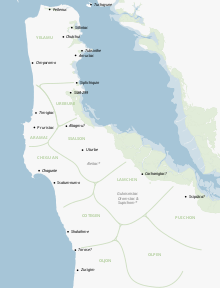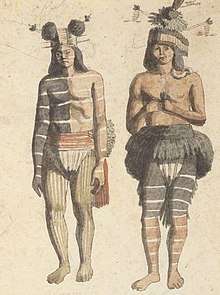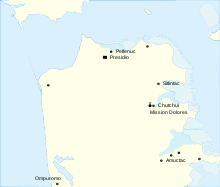Ramaytush
The Ramaytush were one of the linguistic subdivisions of the Ohlone Native Americans of Northern California. Historically, the Ramaytush inhabited the San Francisco Peninsula between San Francisco Bay and the Pacific Ocean in the area which is now San Francisco and San Mateo Counties. The Ramaytush were not thought to be a self-conscious socio-political group. Instead they were defined by modern anthropologists and linguists, initially in the early twentieth century as the San Francisco Costanoans – the people who spoke a common dialect or language within the Costanoan branch of the Utian family. The term Ramaytush was first applied to them during the 1970s.[1]


Historically, Ramaytush language territory was largely bordered by ocean and sea, except in the south where they bordered the people of the Santa Clara Valley who spoke Tamyen Ohlone and the people of the Santa Cruz Mountains and Pacific Coast at Point Año Nuevo who spoke dialects merging toward Awaswas Ohlone. To the east, across San Francisco Bay, were tribes that spoke the Chochenyo Ohlone language. To the north, across the Golden Gate, was the Huimen local tribe of Coast Miwok speakers. The northernmost Ramaytush local tribe, the Yelamu of San Francisco, were intermarried with the Huchiun Chochenyos of the Oakland area at the time of Spanish colonization.[2]
European disease took a heavy toll of life on all tribal people who came to Mission Dolores after its creation in 1776. The Ohlone people were forced to use Spanish resulting in the loss of their language. Hundreds of Ohlone people at Mission Dolores were taken to the north bay to construct Mission San Rafael which was then used as a hospital for sick neophytes. Alfred L. Kroeber claimed that the west bay people were extinct by 1915. The Muwekma Ohlone Tribe, descendants of closely related Chochenyo and Tamyen Ohlone speakers, have been vocal advocates for Native American issues on the San Francisco Peninsula, as have some Ohlone descendants from the Monterey Bay Area farther south.
Etymology
The term "Ramaytush" (Rammay-tuš) meaning "people from the west," is a Chochenyo word the Ohlone of the East Bay used to refer to their westward neighbors.[3] The term was adopted by Richard L. Levy in 1976 to refer to the peninsular linguistic division of the Ohlone.[4]
Ramaytush tribes and villages
Ramaytush groups, for the most part independent territorial local tribes, include:[5]
The Yelamu group, probably a multi-village local tribe, with the following villages within the present City and County of San Francisco:
- Chutchui also listed as Suchui in Mission Dolores Registry – on Mission Creek, the latter in the vicinity of Mission Dolores. The Mission also had a Christianized named for Chutchui which was Neustra Senora de la Asumpcion. The burial ground (shellmound) for Chutchui was located on where the Marshall school (15th Street & Capp Street) is located today[6]
 The location of Yelamu villages within in modern San Francisco
The location of Yelamu villages within in modern San Francisco - Sitlintac also listed as Sitinac in Mission Dolores Registry – near Chutchui
- Amuctac and Tubsinte – in Visitacion Valley, San Francisco.
- Amutaja – Adjoining Canada de la Visitacion (Visitation)
- Petlenuc – near the San Francisco Presidio.
- Mitline – near Lake Merced
- Opurome – beach side of Lake Merced
On San Francisco Bay, south of San Francisco:
- Siplichiquin – on San Bruno Mountain in South San Francisco.
- un-named village CA-SMA-299 on present-day El Camino Real in South San Francisco.
- Urebure – San Bruno Creek near San Bruno Mountain.
- Altamu – San Mateo
- Chachanegtac – Las Pulgas
- Gulcismijtac – North of Las Pulgas
- Ussete – near Las Pulgas
- Chagunte – San Bruno
- Chioischin – San Bruno
- Malsaitac – near San Mateo
- Supichum – San Mateo
- Shalson (spelled Ssalson by Spanish missionaries) along San Mateo Creek and in the contiguous San Andreas Valley (present-day San Mateo). Their permanent or semi-permanent villages included:
- Aleitac – along San Mateo Creek in San Andreas Valley.
- Altahmo – (also spelled Altagmu) – along San Mateo Creek, in San Mateo or in the San Andreas Valley.
- Tunmuda – near San Mateo Creek
- Uturbe – along San Mateo Creek, probably in San Mateo, less likely in the San Andreas Valley.
- Lamchin – Las Pulgas Creek in present Redwood City and to the west on upper Union Creek.
- Puichon – lower San Francisquito Creek and nearby areas (present-day Cities of Palo Alto and Mountain View).
On the Pacific Coast, south of San Francisco:
- Aramai – coastal valleys just south of San Francisco. Its constituent villages were:
- Timigtac on Calera Creek in modern-day Pacifica.
- Pruristac on San Pedro Creek in modern-day Pacifica.
- Chiguan
- Ssatumnumo – Princeton Point
- Chagunte – near Half Moon Bay [7]
- Cotegen – Tunitas Creek and adjoining areas south of Half Moon Bay.
- Oljon – Lower San Gregorio and Pescadero creeks, north of Point Ano Nuevo.
Other Villages (known as Rancherias by the Spanish) listed in San Francisco Mission De Asiss registry that are not given specific locations:[8]
- Aluenchi
- Amictu
- Atarpe
- Chimus
- Chirau
- Chocoayco
- Chupanes
- Chynan Jumiamuc
- Conap
- Cosapa
- Geluasibe
- Liuanegtur
- Macsinum
- Olestura
- Ousint
- Payesone
- Puichon
- Pusuay
- Septuca
- Subchiam
- Toquisara
- Tuzsint
- Uturpe
Ramaytush Ohlone people
- 1777 – Chamis of the village Chutchui. On June 24, 1777, at age 20 he became the first neophyte to join the Mission San Francisco by baptism.[9] He was given the Christian name of Francisco Moraga. No Mission Indian would be given a last name. Chamis would also be the first to be married on April 27, 1778 to the Ohlone woman with the Christian name Catarina de Bononia. Between 1777 and 1850 7,280 Ohlone people were baptized at Mission Dolores.[10]
- 1777 – Pilmo from Playa de la Dolores is 2nd baptized on June 24, 1777 and given the name Jose Antonio.[10]
- 1777 – Taulvo from Playa de la Dolores is 3rd baptized on June 24, 1777 and given the name Juan Bernardino.[11]
- 1777 – Xigmacse, A Yelamu chief, at the time of the establishment of the Mission San Francisco.[12]
- 1779 – Charquín, given the baptismal name of Francisco in the same year, appears to have been the leader of the first band of runaways in 1789. Exiled to San Diego, he died there in the spring of 1798.[13]
- 1783 – Mossués, captain of the village Pruristac, baptized in 1783[14]
- 1797 – Valeriano and Jorge elected Alcalde of Mission SF de Assis. California's first governor Felipe de Neve ordered the Missions to elect local Alcaldes around 1779.[15]List of pre-statehood mayors of San Francisco
- 1797 – Acursio and Fermin elected regidores (council members) at Mission SF Assis.[15]
- 1798 – Biridianna, last living Chutchui villager to have witnessed the founding of Mission Dolores.[16]
- 1804 – Poylemja, ceremonially reburied at Dolores cemetery.[17] {not Ramaytush but Chochenyo}
- 1807 – Hilarion and George (their baptismal names) were two Ohlone men from the village Pruristac who served as alcaldes (mayors) of the Mission San Francisco in 1807.[18]
- 1807 – Jocnocme, ceremonially reburied at Dolores cemetery.[17]
- 18?? – 1823- Pomponio of Half Moon Bay led raids against Mission Dolores, taking livestock and horses. He was caught, escaped, recaptured, and then executed.[19][20][21]
- 18?? – Monica worked as a boatman for William Richardson, who built the first house in Yerba Buena in 1836. Monica told Richardson about the oral history of a time prior to the opening now known as the Golden Gate.[22]
- 1842 – José Antonio – age 16, one of the last twelve known ohlone living in SF.[23] All Ohlone people at the Mission would be given the name of a catholic saint upon baptism. None would be given a last name and be designated in the census as either a neofita or neofito in the census.
- 1842 – Alejo – age 35, one of the last twelve known ohlone living in SF.[23]
- 1842 – Pablo – age 18, one of the last twelve known ohlone living in SF.[23]
- 1842 – Junipero – age 43, one of the last twelve known ohlone living in SF.[23]
- 1842 – José Ramon – age 16, one of the last twelve known ohlone living in SF.[23]
- 1842 – Josefa – age 14, one of the last twelve known ohlone living in SF.[23]
- 1842 – Consolacion – age 12, one of the last twelve known ohlone living in SF.[23]
- 1842 – Ygnacio – age 53, one of the last twelve known ohlone living in SF.[23]
- 1842 – Dunas – age 49, one of the last twelve known ohlone living in SF.[23]
- 1842 – Forcuata – age 40, one of the last twelve known ohlone living in SF.[23]
- 1842 – José – age 16, one of the last twelve known ohlone living in SF.[23]
- 1842 – José D. – age 3, one of the last twelve known ohlone living in SF.[23]
- 1893 – Pedro Evencio has been called the last (Ramaytush) Native American of San Mateo. His son José Evencio lived at Coyote Point until World War II; his final whereabouts are unknown.[24]
- 1950s – Andrés Osorio of Half Moon Bay, said to be the area's last "Indian", possibly Tulare or Mexican.[24]
Notes
- Levy in Heizer 1974:3
- Milliken 1995:260
- Erickson, Evelyn Arce. "Thanksgiving is a season of both gratitude and mourning". Half Moon Bay Review. Retrieved July 22, 2020.
- Golla, Victor (August 2, 2011). California Indian Languages. University of California Press. ISBN 978-0-520-26667-4.
- Milliken 1995
- San Francisco Call, January 7, 1910 – page 16
- Historic Resource Study for Golden Gate National Recreation Area in San Mateo County, p. 26
- Englehardt, pg 410-11
- Milliken, 1995:68.
- Engelhardt, 1924.
- Engelhardt, 1924.
- Muwekma website – history Archived December 11, 2005, at the Wayback Machine.
- Milliken 1995:120
- Milliken, 1995:80-81m.
- Englehardt, pg 121
- San Francisco Call April 10, 1898
- from gravestone at Mission Dolores.
- Milliken, 1995:206–207.
- San Francisco Call January 2, 1910
- Pomponio
- A History of Mission San Rafael, Archangel Archived March 13, 2010, at the Wayback Machine
- http://www.sfgenealogy.com/sf/history/hgfir.htm at the bottom of the page
- 1842 Census
- Brown, 1974
References
- Brown, Alan K. Indians of San Mateo County, La Peninsula:Journal of the San Mateo County Historical Association, Vol. XVII No. 4, Winter 1973–1974.
- Brown, Alan K. Place Names of San Mateo County, published San Mateo County Historical Association, 1975.
- Fr. Engelhardt O. F. M, Zephyrin. San Francisco or Mission Dolores, Franciscan Herald Press, 1924.
- Heizer, Robert F. 1974. The Costanoan Indians. De Anza College History Center: Cupertino, California.
- Milliken, Randall. A Time of Little Choice: The Disintegration of Tribal Culture in the San Francisco Bay Area 1769–1910 Menlo Park, CA: Ballena Press Publication, 1995. ISBN 0-87919-132-5 (alk. paper)
- Teixeira, Lauren. The Costanoan/Ohlone Indians of the San Francisco and Monterey Bay Area, A Research Guide. Menlo Park, CA: Ballena Press Publication, 1997. ISBN 0-87919-141-4.
- 1842 Census of San Francisco